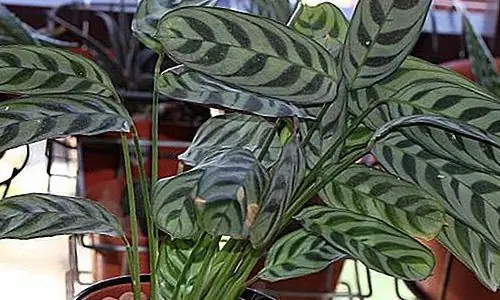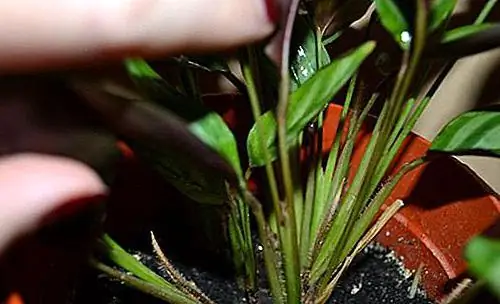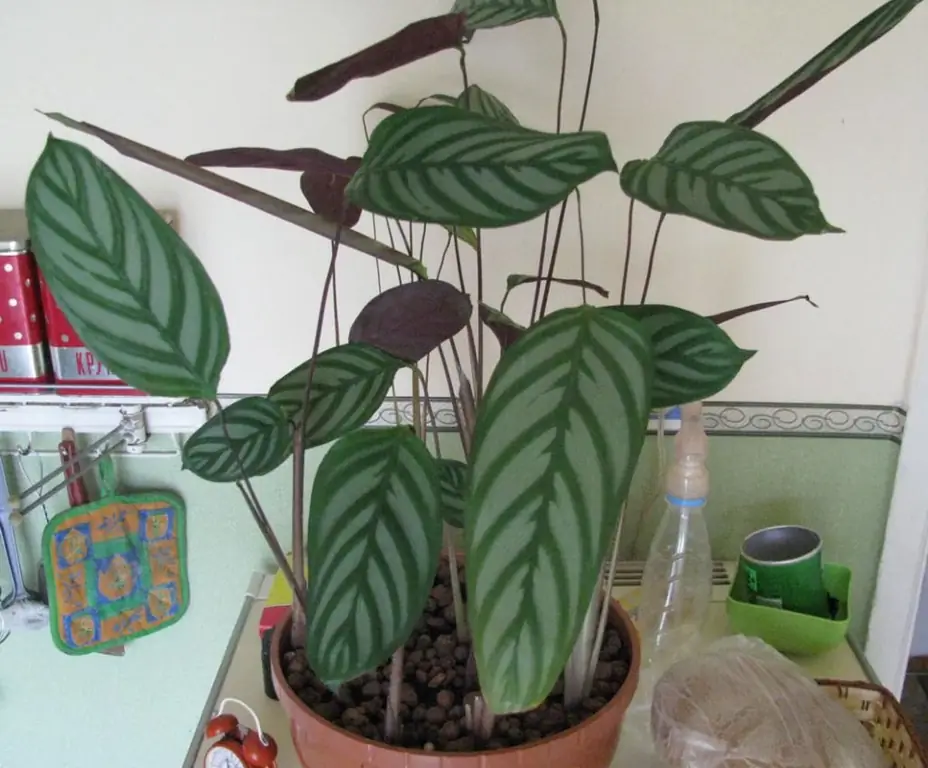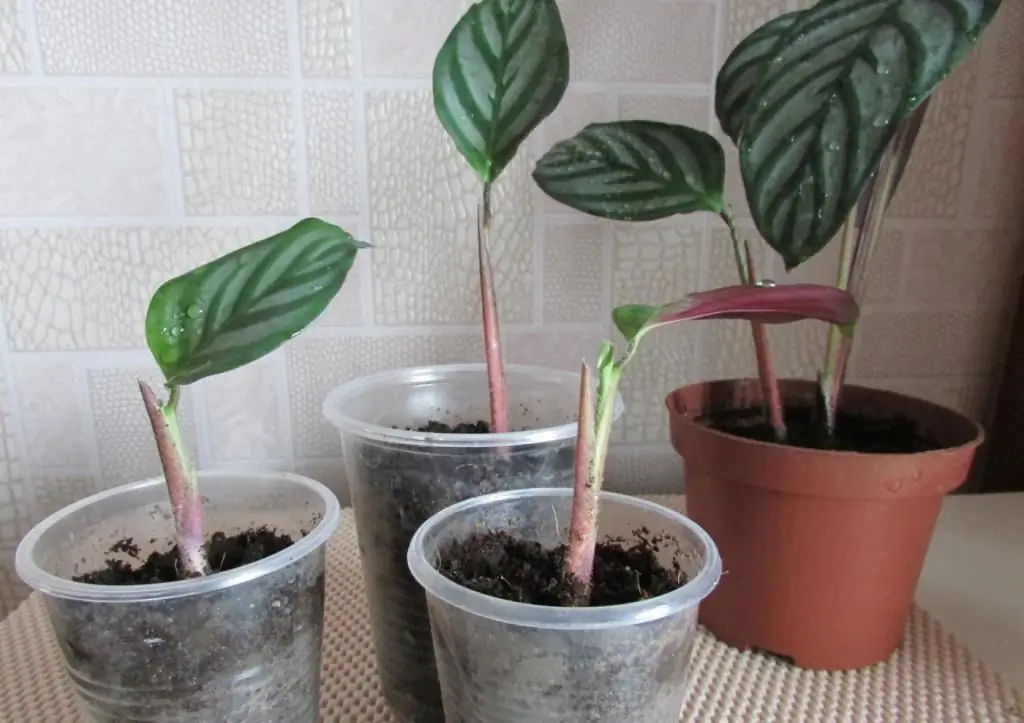Flower growers always try to diversify their collection with a new plant, interesting and unusual. Ktenant Oppenheim is one of the unpretentious, but very original specimens. The flower won the love of flower growers thanks to its original, beautiful color and simple maintenance at home. This is a perennial herb that belongs to the Marantaceae family.

General Description
A feature of Oppenheim's ctenant is that its leaves are oval, narrowed towards the base and asymmetric. This plant has another interesting feature. With the onset of evening, she lifts the leaves up, which creates a slight rustle. This is especially noticeable if there is a large bush on the window. In the morning, it blooms again, spreading the leaves back to their original places.
This plant is native to the tropical forests of Brazil. ThereCtenant Oppenheim grows in swampy areas. Under the cover of tropical trees, the bushes feel very at ease. But in room conditions, you will have to try to create optimal conditions for her.
The most popular member of the family
Indeed, Ktenant Oppenheim is the most frequent guest in residential premises and offices. It can reach 1 meter in height, and the leaves - 40 cm in length. An amazing plant, delicate and bright at the same time. The leaves are oblong, dark green. They have light green and silvery white stripes. The reverse side is purple. A large bush can decorate any room. But besides this variety, the family includes several more:
- Berl-Marx. The height of this plant reaches 40 cm. The leaves are light green, with dark stripes and a purple reverse side. Willingly blooms, throwing out a creamy white inflorescence.
- Ktenant Lubbers - reaches 75 cm in height. A distinctive feature is the beautiful yellow strokes that resemble feathers.
- Ctenant compressed - reaches a meter in height and resembles a palm tree. It is a long bare stem that ends in a knot of 4 leaves.
But today we are interested in Ktenant Oppenheim. Caring for this plant is quite simple, but you need to take into account some features and nuances. All other varieties have been mentioned for comparison purposes so you can tell them apart.

Decorative foliage plant
Often flower growers believe that the best evidencegood care for a green pet is flowering. In fact, not all plants are valued for their beautiful buds and petals. A prime example would be a ctenant. Caring for her may be perfect, but the released inflorescences will upset you with their nondescriptness. But luxurious leaves with strong petioles are the main advantage of the plant. Therefore, care should be aimed at increasing the green mass.
Home care
Ctenant Oppenheim is a visitor from the rainforests. And its place is the lower tier, that is, growing under the shade of larger plants. Keep in mind that this also implies a high level of humidity. In addition, the plant does not tolerate temperature changes and drafts. To get a beautiful, sprawling bush, you need to create almost greenhouse conditions. In apartments, the air temperature is usually high, but it is very dry, which the plant categorically does not like. Therefore, it is required to install air humidifiers or build a kind of greenhouse with an open front wall. Moisture will trap and evaporate in this hood.
At first glance it seems that caring for Oppenheim's ctenant is very difficult. In fact, you need to think over the placement of this pet once and purchase the necessary equipment - and as a reward you will receive a luxurious plant with beautiful leaves.

Lighting is another challenge
This is the second point that those who want to grow a ctenant stumble over. Home care for a capricious beauty is complicated by what you needyourself on the window to create a piece of rainforest. Beforehand, it would be good to imagine in what conditions the flower grows in its natural environment. The fact that it should be warm and sunny has already been said. But you need to solve the issue with lighting.
The plant in this regard is not too demanding. In nature, ctenants grow under the canopy of large trees, so they do not suffer from a lack of sun. Moreover, direct sunlight is contraindicated for them. A dim, diffused light is best. But if it is not enough, then the new leaves will have shorter plates. Bushes in a northern or western room will feel great.
If the windows of your home face south, then the plant should be placed in the back of the room or shaded. Otherwise, the leaves may lose their bright color. But in a similar way, they will react to a too dark location. It is especially important to shade the plant in spring and summer, when the sun's rays are especially bright.

Irrigation
Often this very moment becomes a stumbling block for the owner. Photos of Oppenheim's ctenant with drooping leaves and dried edges are often presented to specialists to help them deal with the problem. And it is solved very simply: the plant simply does not have enough moisture. But this can not always be solved by increasing the frequency of watering.
The plant needs a lot of watering, but "bogs in a pot" should not be allowed. Excess moisture can lead to root rot. Overdrying is no less dangerous, in this case, damage to the leaves and shoots occurs. I.eit is not recommended to allow the earthen coma to dry out, but it is also impossible to introduce a new portion of moisture when the earth has not yet dried out. Therefore, the frequency of watering will be different in summer and winter.
And one more thing. Water for irrigation should be soft and always warm. It must be defended or filtered. The second option is even better, because the plant reacts very poorly to an excess of mineral s alts.
Humidification
Photo of a ctenant grown in good conditions shows a beautiful, lush bush with bright leaves. But in reality, we can often encounter the fact that the leaves begin to shrink, become faded, and the pattern almost completely disappears. Why is this happening? Most often, the problem is excessive dryness of the air. Most often, it is with this question that novice flower growers turn to specialists. Why did the leaves of Oppenheim's ctenant curl up? This variety is very picky about the level of humidity in the air. In addition to drying the tips of the leaves, the plant's immunity usually also decreases, and it becomes a victim of pests and diseases.
So, one watering will not solve this problem. Bathing a flower under a warm shower positively affects growth and development. Make sure that water does not remain on the leaves. To increase the humidity level, you can place the plant pot in a tray filled with damp moss or gravel. But the roots should not constantly touch the water. Usually, this measure is enough for young leaves and he althy basal shoots to appear.

Spraying
If you regularly resort to this method, then you will have an original flower at home, as in the photo. Caring for a ctenant at home must necessarily include spraying. This is especially important in winter, when central heating is turned on.
To do this, be sure to use warm water. It must first be defended, and even better filtered so that a whitish precipitate of s alts does not fall on the leaves. Spray water in very small drops. Large ones leave dark spots on the leaves.
Use fertilizer for Oppenheim's ctenant
Home care for a tropical flower should be complete so that your plant is he althy and beautiful. We talked about external influences. But the roots of the plant are in the ground, so you need to pay attention to this important factor. We have already said above that the soil should be moist, but not wet. But that's not all the requirements.
The soil should be loose, slightly acidic and consist mostly of leaves. It is very important to add peat, charcoal, humus and coniferous soil to it. Coarse sand will make the substrate more crumbly. You can do a little experiment. Take a handful of soil and squeeze. If after that the composition crumbles freely, then it is suitable for planting.
Potted plants are severely limited in their ability to obtain nutrients. In nature, they are updated naturally, through the decay of foliage and insects. Yes, and the roots of the plant can grow insides. In the pot, the plant only has what you give it. Therefore, it is necessary to regularly replenish the supply of nutrients, as well as change the soil.
Feeding rules
Ktenanta does not like excess fertilizer, this must be taken into account and restrain your desire to often water it with nutrient compounds. Her well-being is badly affected by the increased level of calcium and nitrogen in the soil. In the cold season, it will be enough for a pet to feed once a month. In spring and summer, this procedure should be performed more often - once every two weeks.
Which fertilizer to choose for this? It is best to take complex compositions for indoor decorative leafy plants. The most convenient fertilizer is recognized in liquid form. And one moment. The instructions always indicate a high dosage. It is recommended to use half the dose.
But there is another option. If you have prepared high-quality soil, then the plant will not lack nutrients. An annual transplant serves the same purpose. If you adhere to the principles of regular renewal of the soil in pots, then you can not think about top dressing. They will just be redundant.
Transfer
We have come close to the fact that the plant needs regular transplants. This is an important rule so that you can proudly show off a photo of a chick. Home care for this flower involves regular inspection of the pet. If you see that the soil begins to dry out quickly, and roots are visible through the drainage holes, then it's time to start transplanting.
Youngspecimens are recommended to be transferred to a new pot every year, choosing a slightly larger container. The second half of spring is best suited for this. Large plants need only one transplant every 3-5 years. It is very important to choose the right size pot. Its diameter should be only a few centimeters larger than the previous one. Too much volume can kill the plant. In this case, it is likely that the excess earth will turn sour. Preference should be given to ceramic flowerpots. In this case, evaporation of excess moisture is possible through the side walls.
If the plant does not need to be transplanted, but you want to renew the soil, then transshipment is performed. In this case, the topsoil is carefully removed and replaced with fresh. The procedure does not injure the plant at all, and it continues to grow willingly.
Reproduction
In the process of transplanting, you can think about how to plant another young plant for yourself. The easiest way to do this is by dividing the rhizome. Unrooted plants need little to no water, so it's best to cover the pot with a plastic bag and leave it alone. The first watering will be sufficient until roots appear.

The second option is rooting in water. This is a method loved by flower growers for its clarity. Roots usually appear after 4-6 weeks. After that, the plants need to be planted in a peat-based substrate and placed in a mini-greenhouse with high humidity and temperature. But propagation by seeds is practically not practiced, so we will notstop there.

Diseases and pests
This is a rather delicate tropical plant, the condition of which requires constant monitoring. Ktenanta is susceptible to diseases, which are most often manifested by spots on the leaves. There can be many reasons. The plant is affected by fungal and viral diseases. In addition, with a decrease in immunity, the flower becomes an easy prey for pests.
If brown spots appear on the leaves, then you need to carefully examine the plant, check the condition of the soil. If it is moderately wet, then most likely the reason lies in the activity of pests. This is a spider mite or scale insect. To save your plant and restore its decorative appearance, you need to spray it with an insecticide in time.
Instead of a conclusion
Despite the fact that this plant is a guest of their tropics, it gets along quite successfully at home. By taking into account the needs of the ctenant and creating optimal conditions for it, you can count on the fact that a luxurious bush with striped leaves will flaunt on the window. And it will not take you a lot of time and effort. Even though the plant does not bloom, or rather, it produces rather nondescript inflorescences, but the beauty of the leaves compensates for this shortcoming. Today we looked at the features of caring for this plant. This can serve as a guide for beginner growers.






